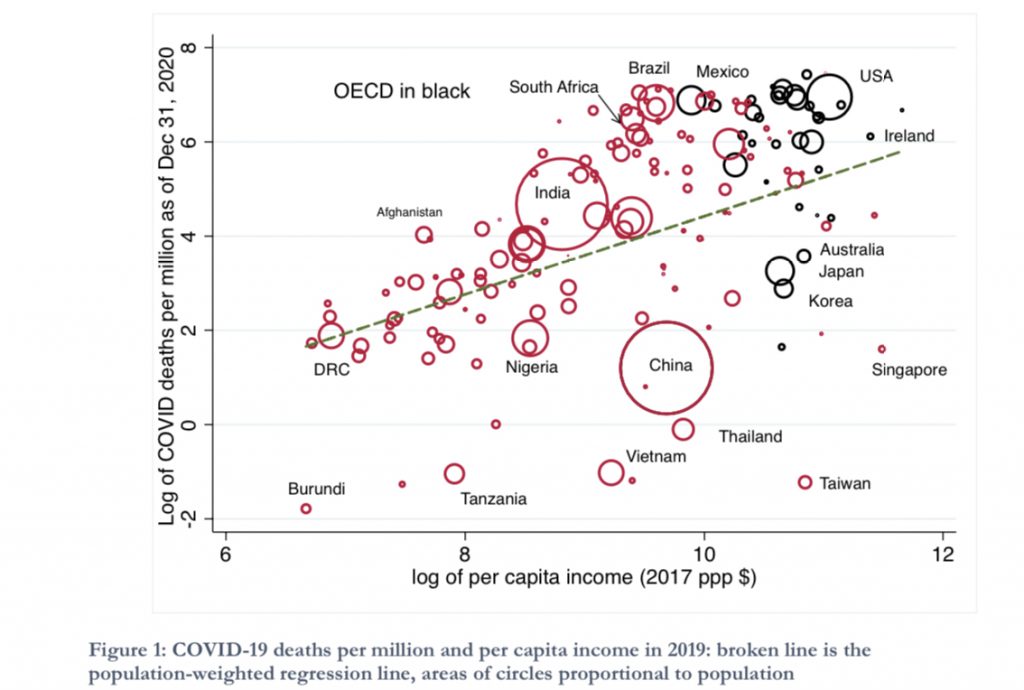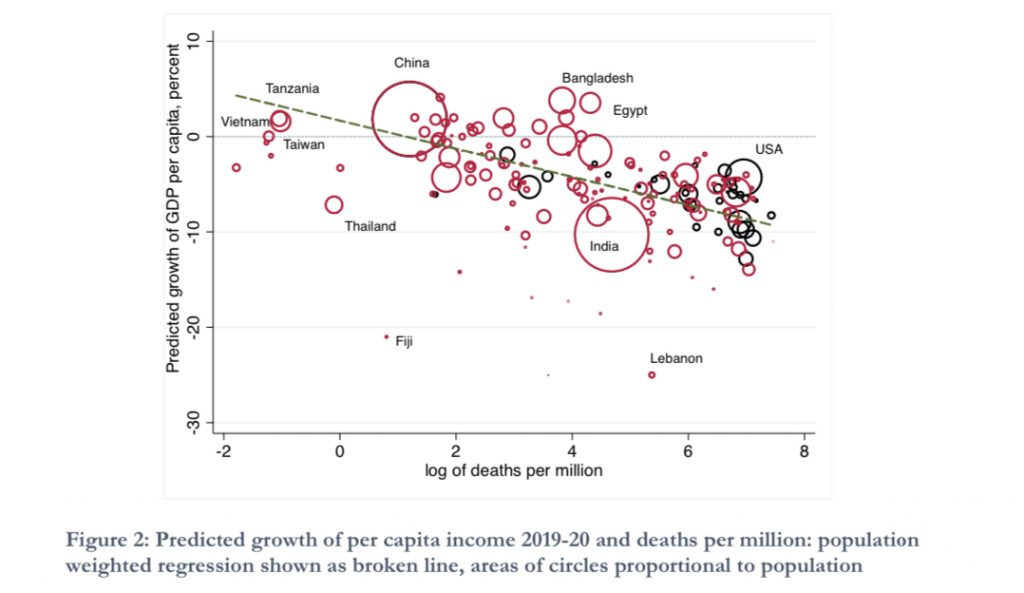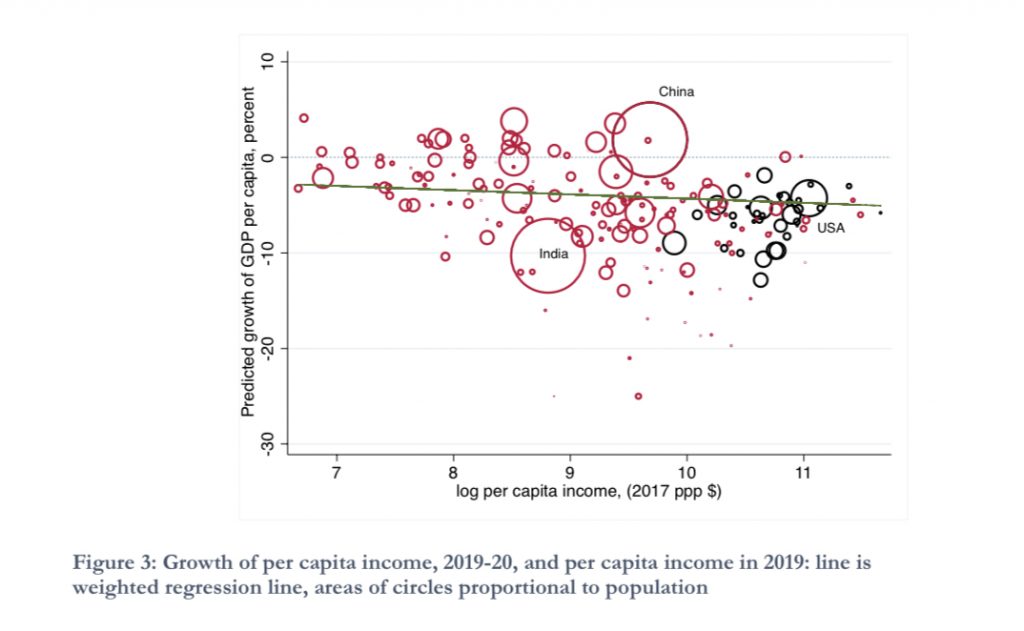One of the hottest topics in the economic sphere since the outbreak of the COVID-19 pandemic is how it would affect the global economy and what the effects would be on variables such as economic growth, poverty or income inequality. Although at the beginning of the pandemic it seemed that the shock at the economic level would be relatively symmetrical, it has finally consolidated as a rather asymmetrical shock in terms of variables such as economic growth or increased unemployment.
One of the most complex issues to analyze at the economic level and in relation to the pandemic is its effect on inequality. Mainly because the pandemic is not yet over, and until herd immunity is achieved thanks to mass vaccination, it will not be possible to recover a level of economic activity at least similar to that which existed prior to February-March 2020 in the West. Even so, the data available so far show certain trends about the effect of COVID-19 on global income inequality and, recently, Angus Deaton, winner of the Nobel Prize in Economics in 2015 and professor at Princeton, published a paper entitled “COVID-19 and Global Income Inequality,” in which he presents several valuable results.
The COVID-19 crisis has had a greater disruptive effect on those citizens with lower education and lower wages, as a greater proportion of those jobs could not be developed remotely, which has contributed to the employment of those workers with higher education and higher incomes being more protected relative to those less qualified, who have lost their jobs to a greater extent. This has led to hasty conclusions about what the effects of the pandemic would be on income inequality, and indeed many economists such as Stiglitz (2020) or Goldin (2020) were quick to claim that the pandemic would have a massive amplifying effect on income inequality.
Even so, the data does not corroborate this version -at least not completely- and Deaton (2020) has analyzed the available evidence and concluded that global inequality -if we treat each country as an element of the global sample and do not weight by population- has not increased, but has decreased. On the other hand, if we weight each country by its population, we find that global income inequality has increased as a result of the pandemic, but not because of what is usually thought, since the incomes of poor countries have NOT fallen proportionally more than those of rich countries (quite the contrary), but because China in the global distribution is no longer a poor country, but a rich country, so by having the largest population in the world and having been the only country with positive GDP growth in 2020, its rise has not contributed to a decrease in inequality -as it happened when China grew more than the rest in the last 40 years- but to an increase in inequality.
To give us an idea, out of the world’s population of 7.8 billion people, 4.4 billion live in countries whose GDP per capita is lower than China’s, and only 2 billion live in countries whose GDP per capita is higher than China’s. Therefore, in a global income distribution in which countries are weighted by population, if China grows more than the rest, today, it contributes to increasing inequality and not to reducing it, as was the case when China was in the lower half of the distribution.
The pandemic has also contributed to increasing levels of absolute poverty globally. According to World Bank estimates (2020), between 88 and 115 million people would have fallen below the absolute poverty level as a result of the pandemic. Even so, per capita GDP in poor countries has declined less than in rich countries. The fact that poverty in the least developed countries has increased the most is that ex-ante a much larger proportion of their population lived just above the absolute poverty line.
Let us now proceed to explain the methodology for measuring the effect of the pandemic on inequality. Deaton uses two different measures to calculate this effect. First, he calculates the dispersion of GDP per capita across countries without weighting by population. That is, each country is an element of the sample and has the same weight as the rest, without taking population into account. Inequality is then calculated in the same way as it would be for a group of individuals. The second way to measure inequality is to weight each country by its population. In other words, the sample would consist of the 7.8 billion inhabitants of the world, each one is attributed the per capita income of his country, and from there the dispersion of income at the global level is calculated. Prior to the pandemic, both measures of inequality showed the same trend result: a steady decline in international income inequality.
To calculate the effects of the pandemic on inequality, Deaton uses data from Our World in Data (2020) for deaths per million population by country, and from the IMF for GDP per capita by country, adjusted to PPP in 2017 international dollars. Figure 1 shows the regression line with the logarithm of 2019 per capita income by country as the independent variable and the logarithm of deaths per million population as the dependent variable. Also, the areas of the circles represent the population level of each country. OECD countries are shown in black and non-OECD countries in red. The slope of the regression line is 0.83 for the population-weighted measure and 0.99 for the unweighted measure. The interesting result comes if we eliminate China from the computation – since it is the main outlier both in terms of low number of deaths per million and population size – showing that eliminating it from the computation would nullify any statistically significant relationship between level of GDP per capita and deaths per million due to the pandemic.
Deaton points out that this would show how the COVID-19 pandemic and its effects would break with the vast majority of previous studies on the relationship between GDP levels and better health and disease prevention. For the case of the COVID-19 pandemic “wealth is health” would not strictly hold true. The higher number of deaths per million due to the pandemic in developed versus less developed countries could be due to a multitude of factors: errors in the measurement of the data, an older population in developed countries, higher population density in most developed countries and so on.

Furthermore, Deaton studies the relationship between deaths per million due to COVID-19 and the rate of change of GDP in 2020. Figure 2 shows the regression line with the logarithm of deaths per million population as the independent variable and the estimated rate of change of GDP for 2020 as the dependent variable. The slope of the line is -1.5 for the weighted regression and -0.94 for the unweighted regression. This shows that countries that suffered higher mortality from the pandemic also experienced greater economic destruction.

Third, we attempt to study whether there is any relationship between pre-pandemic GDP levels and the rate of change in 2020 GDP. To this end, Figure 3 constructs a regression line with the logarithm of GDP per capita in 2019 adjusted to PPP with 2017 international dollars as the independent variable and the estimated rate of change of GDP for the year 2020 as the dependent variable. The slope of the regression line is -0.44 for the population-weighted regression and -1.6 for the unweighted regression. Here the two main outliers are China and India although in opposite directions, as can be seen. The inverse relationship between 2019 GDP per capita and growth rate in 2020 is applicable globally in 2020 for both OECD and non-OECD countries. Here it is worth noting that the fact that the richer countries have suffered a greater proportional fall in GDP in 2020 than the poorer countries does not mean that this has automatically caused a global reduction in income inequality.

Finally, Deaton presents a graph (Figure 4) comparing how global income inequality has evolved from 1995 to the present day, highlighting the evolution of the last year. To do so, he calculates the standard deviation of the logarithms of the level of GDP per capita per country, adjusted to PPP. It uses two data sources: two IMF reports, the first from October 2019 and the second from 2020 in the middle of the first wave, the data from the first being represented by the dashed lines and those from the second by the continuous ones. The three measures it uses to construct the different samples are: GDP per capita data by country unweighted by population, data weighted by population level and, finally, data weighted by population level excluding China. As can be seen in Figure 4, inequality at the international level has been falling steadily since 1995 -with small annual upturns- regardless of the sample or data source used. The difference is found in the year 2020, in which the population-weighted sample including China shows an increase in inequality, while the sample weighted excluding China and the sample unweighted by population (especially this one) show a decrease in global income inequality levels.

The available data show that the pandemic has led to a contraction in GDP per capita levels in 2020 in all countries, with the major exception of China. The richest countries have in turn been those that have registered – and are registering – the most deaths per million inhabitants due to the pandemic. Moreover, these same countries have also suffered the greatest contractions in GDP per capita, which means that, when the global sample of countries is weighted by population, a slight increase in global income inequality levels can be observed, caused mainly by the growth of China compared to the economic collapse of the rest of the countries. Remember that today China is in the top half of the distribution of GDP per capita by country, which means that its above-average growth rates no longer contribute to reducing international inequality – as has been the case over the last four decades – but to increasing it, this being the main explanation for the relative increase in global income inequality due to the COVID-19 pandemic, when weighted by population.
